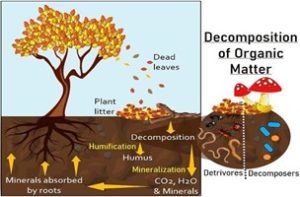Life in Dirt: Feeding the Millions – Unraveling the Marvels of Soil Microbial Diversity


When we gaze at vast fields of crops swaying gently in the wind, we seldom think about the intricate world beneath our feet, where life teems in a complexity that rivals any bustling city. The soil, often overlooked, is a universe in itself, hosting a plethora of organisms, among which soil microbes stand out as silent heroes. These tiny life forms, invisible to the naked eye, play an indispensable role in our lives, especially when it comes to feeding the millions.
At first glance, soil might appear as just dirt, but it’s far more than that; it’s a bustling ecosystem where countless organisms thrive. Among these, soil microbes, including bacteria, fungi, and protozoa, are the unsung champions. They are nature’s recyclers, breaking down organic matter, releasing essential nutrients, and ensuring the fertility of our lands.
Soil microbial diversity, referring to the variety of these microscopic organisms, is a crucial factor in maintaining the delicate balance of our ecosystems. These tiny beings are the major regulators of fundamental ecosystem processes, such as organic matter decomposition, nutrient cycling, and gaseous fluxes. In simpler terms, they are the architects of life beneath the surface.
With only 2.4% of our land being arable, our country faces immense pressure to feed a population of 1.4 billion people1. In the pursuit of food security, we often adopt technologies without adequate testing. For instance, the introduction of Nano urea was touted as a solution, promoted by organizations like the IFFCO (Indian Farmers Fertiliser Cooperative Limited), claiming it to be beneficial for production and a replacement for traditional urea. However, recent research has indicated that the use of Nano liquid urea could result in significant yield losses2. Indiscriminate use of fertilizers, manures, pesticides, herbicides, or similar soil amendments has a profound adverse effect on soil microbial diversity. These microorganisms, vital for sustaining life in the soil, play a pivotal role in regulating essential ecosystem functions. This includes breaking down organic matter and cycling nutrients, which are crucial for maintaining soil productivity. To meet the increasing demand for food and ensure food security, our excessive greed has driven us to apply more and more fertilizers. However, this practice of soil nutrient enrichment has led to a situation of nutrient immobilization. It’s akin to the tale of the greedy farmer who, in his eagerness for more, ended up harming the very source of his wealth, much like the farmer who killed the hen that laid golden eggs3.
Soil bacteria, fungi, actinomycetes, nematodes, and protozoa are important drivers of biogeochemical cycles4. The intricacies of microbial interactions remain a mystery, and scientists are actively investigating microbe-to-microbe communication. Simultaneously, due to human activities, numerous microbial species and other small soil organisms might be facing extinction, often without our awareness5. Take, for instance, Mycorrhiza, a microorganism recognized for its ability to establish a symbiotic relationship with plant roots, aiding in nutrient absorption from distant areas. Improper and excessive application of inorganic fertilizers results in a decline in these advantageous microbial communities6.
In addition to the issue of excessive land use, it’s alarming to note that according to the Food Safety and Standards Authority of India (FSSAI), one-third of all food produced in India goes to waste or spoils before reaching the consumer’s table. The Ministry of Agriculture in India has quantified this wastage at nearly 50,000 crore INR annually7. However, the repercussions of this wastefulness extend far beyond mere financial losses; it encompasses the depletion of precious natural resources and the hard work of essential microorganisms.
The situation is graver than it appears. It’s not merely a matter of monetary loss; it involves the depletion of valuable natural resources and the efforts of vital microorganisms. This issue arises primarily due to a lack of awareness and carelessness, factors that contribute significantly to this widespread wastage. It’s imperative that we address this problem urgently, adopting measures to raise awareness and promote responsible consumption to mitigate these losses and conserve our resources. In the grand tapestry of life on Earth, microorganisms have been thriving for billions of years, long before humans came into existence. Over the course of these eons, they have painstakingly acquired genes that now play a crucial role in enhancing our productivity and ensuring the sustenance of our ecosystems. It is not just a responsibility but a moral obligation for us to uphold this delicate balance of nature.
By embracing the principles of organic and sustainable agriculture, we can harmonize our endeavors with the natural world, acknowledging the profound contributions of these microscopic beings. Our journey towards sustainability hinges on our ability to understand and respect the intricate web of soil microbial communities. It is incumbent upon us to invest in research initiatives that delve deeper into the mysteries of this unseen world. While the allure of short-term gains and heightened productivity might tempt us, we must not lose sight of the greater, long-term goal: ensuring the continuity of life on Earth. This continuity is intrinsically linked with the world of microbes. As stewards of this planet, we must tread wisely, nurturing our relationship with these tiny but indispensable life forms. Only by embracing the microbial world and working in harmony with it can we hope to achieve a sustainable future for ourselves and for the countless generations yet to come.
References
- Kumar, A., Bhople, B.S. and Kumar, A., 2020. Prospective of Indian agriculture: highly vulnerable to huge unproductivity and unsustainability. Current Science, 119(7), p.1079.
- Frank, M. and Husted, S., 2023. Is India’s largest fertilizer manufacturer misleading farmers and society using dubious plant and soil science?. Plant and Soil, pp.1-11.
- Kumar, K.A. and Mahapatro, G.K., 2014. Pseudo-imitation through phospholipid fatty acid (PLFA) analysis-possibly paves the way to sustainability. Current Biotica, 7(4), pp.251-252.
- Van Der Heijden, M.G., Bardgett, R.D. and Van Straalen, N.M., 2008. The unseen majority: soil microbes as drivers of plant diversity and productivity in terrestrial ecosystems. Ecology letters, 11(3), pp.296-310.
- Lahlali, R., Ibrahim, D.S., Belabess, Z., Roni, M.Z.K., Radouane, N., Vicente, C.S., Menéndez, E., Mokrini, F., Barka, E.A., e Mota, M.G.D.M. and Peng, G., 2021. High-throughput molecular technologies for unraveling the mystery of soil microbial community: Challenges and future prospects. Heliyon, 7(10).
- Zhu, C., Ling, N., Guo, J., Wang, M., Guo, S. and Shen, Q., 2016. Impacts of fertilization regimes on arbuscular mycorrhizal fungal (AMF) community composition were correlated with organic matter composition in maize rhizosphere soil. Frontiers in Microbiology, 7, p.1840.
Web References
By
Dr Arun Kumar K
Senior Assistant Professor
Integrated M.Sc Biotechnology


